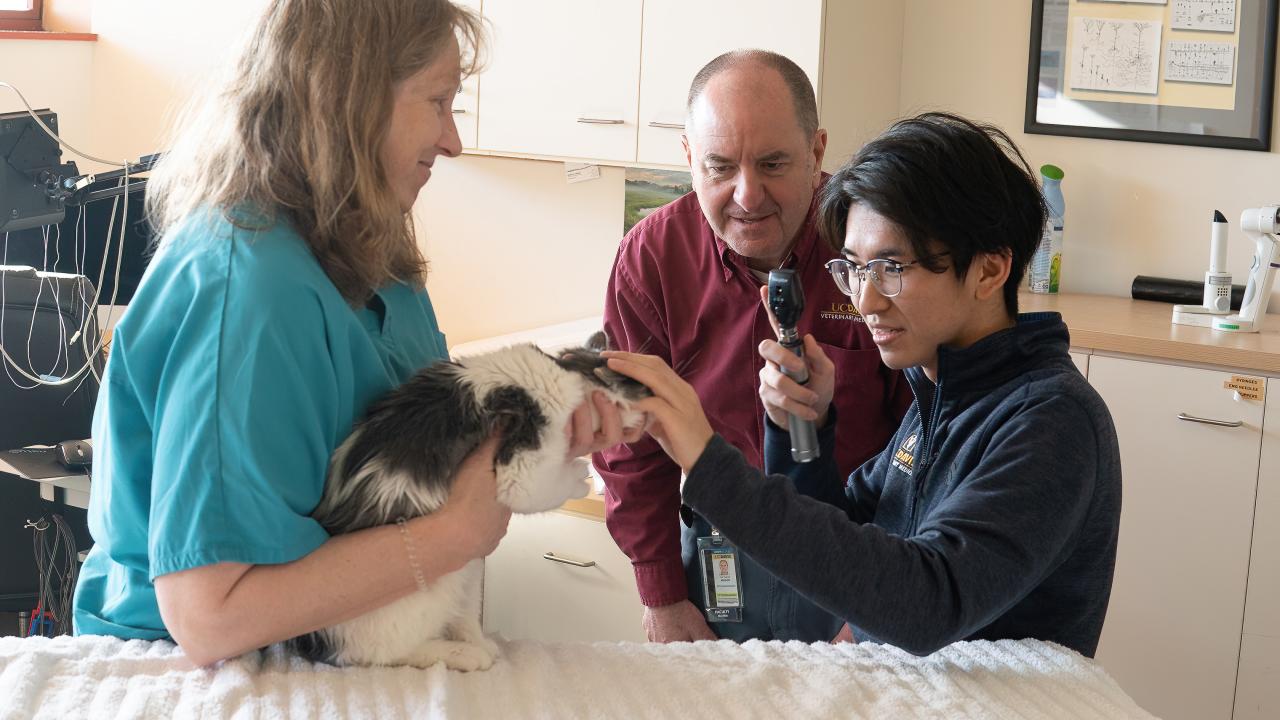UC Davis study on eye diseases in kittens
Study shows a complex, but treatable disease with 40 patients
UC Davis School of Veterinary Medicine professors, Karen Vernau (left) and David Maggs (center) mentor student Hikaru (Ray) Shiraishi (right) on the proper techniques of examining a kitten's eyes. (Photo courtesy of UC Davis)

According to a university release1 from UC Davis School of Veterinary Medicine, over the past 20 years, the eye disease symblepharon has only been studied in 5 published papers covering 20 kittens. This condition can be blinding to the car and occurs when the conjunctiva—the pink tissue surrounding the eye—fuses with other nearby surface structures of the eye or eyelid soon after birth, likely secondary to a feline herpesvirus infection on the ocular surface. Symblepharon is commonly seen in feline medicine practice, yet veterinary academic literature has been limited and inconclusive.
UC Davis recently published its own study2 on symblepharon using 40 kittens (in a total of 54 eyes) on February 6, 2023, to retrospectively evaluate the signalment, treatment, surgical technique, and outcomes for feline symblepharon.
“There is a misconception that this disease is not treatable or that it has a high rate of recurrence,” said David Maggs, BVSc (hons), DACVO, a professor of ophthalmology at UC Davis, said in the release. “We were able to separate out that smaller percentage of cases that do recur from those that respond much better to therapy, and to determine that this is not one homogenous disease. Many of these cases were previously being referred for enucleation (removal of eye), but we discovered that almost all these kittens have visual, comfortable eyes that can be saved.”1
The study began with kittens that had a clinical diagnosis of symblepharon between January 1, 2002, and May 31, 2022, identified through a digital search of electronic medical records from the University of California Davis Veterinary Medical Teaching Hospital. All the kittens that participated were less than 1 year of age at the time of initial diagnosis.
The results
There were 5 types of symblepharon found in various combinations: eyelid deformation (24 kittens; 32 eyes); ankyloblepharon (4 kittens; 4 eyes); conjunctiva-to-conjunctiva (11 kittens; 12 eyes); third eyelid-to-conjunctiva (24 kittens; 29 eyes); and corneoconjunctival adhesions (14 kittens; 16 eyes). At initial presentation, 23 (43%) eyes were affected by 1 type of symblepharon, 25 (46%) eyes by 2 types, and 6 (11%) eyes by 3 types.2
Surgery was performed under general anesthesia/sedation (30 occasions) or topical anesthesia (21 occasions) on 30 (56%) eyes of 22 kittens; 12 eyes (40%) underwent multiple surgeries. There were 4 surgical techniques used, including: separation of conjunctival-to-conjunctival adhesions ± eyelid margins (14 eyes); resection of third eyelid adhesions ± temporary tacking of the third eyelid (modified Arlt’s pterygium technique; 18 eyes); en bloc resection of the third eyelid (2 eyes); and separation of corneoconjunctival adhesions (14 eyes).2
From there, the researchers concluded that some forms of the disease were more amenable to surgical treatment than others and the surgery needed was relatively simple in some cases. The study also introduced a new surgical technique for managing this disease.
“By carefully identifying which type of symblepharon a kitten may have, the surgery to correct two of the types could be performed by a general practitioner. This could allow shelter veterinarians to correct the condition at the time of neutering. In fact, many of the surgeries documented in this study were performed by our Community Surgery Service,” said Karen Vernau, DVM, MAS, DACVIM (Neurology), a clinical professor of neurology/neurosurgery who works with many shelters and rescue groups through the Access to Care Program at UC Davis.1
UC Davis undergraduate student, Hikaru (Ray) Shiraishi, took the lead on this study and became acquainted with the Ophthalmology Service through his work with the Vet Aide Club, a student organization that allows undergraduates to gain practical, hands-on experience in a variety of animal care fields. Shiraishi was offered a student position as an animal technician with the Ophthalmology Service and was ultimately recommended by the ophthalmology faculty to take on this research project.
References
- Study shows complexity and treatability of eye disease in kittens. News release. UC Davis School of Veterinary Medicine. Published March 17, 2023. Accessed March 20, 2023. https://www.vetmed.ucdavis.edu/index.php/news/study-shows-complexity-and-treatability-eye-disease-kittens
- Shiraishi H, Vernau KM, Kim S, et al. Symblepharon in kittens: a retrospective study of 40 kittens and 54 eyes (2002-2022). J Feline Med Surg. 2023;25(2):1098612X221150160. doi:10.1177/1098612X221150160